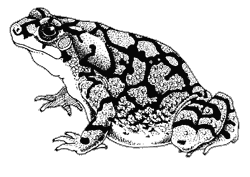Sonoran Green Toad
(Anaxyrus debilis)
Order: Salientia
Family: Bufonidae (true toads)
Other common names: reticulated toad
Spanish name: sapo
Distinguishing Features
The Sonoran green toad is small, reaching only 2½ inches (57 mm) in length. Brightly colored, this toad is green to greenish-yellow with reticulations (net-like lines) or spots of black or brown on the back and legs, and numerous small, black-tipped warts on the back and sides. The underside is white with an occasional speck or two of black. The parotoid glands are large. Males have a dark throat.

Range
Endemic to the Sonoran Desert region, this toad is found from south-central Arizona to west central Sonora.
Habitat
The Sonoran green toad is found along washes in mesquite grasslands and creosote bush flats between 500 and 1500 feet (150 to 450 m).
Life History
Once the summer rains begin, males move into grasses around temporary rainwater pools and washes and begin to call. The call lasts a few seconds and sounds like a combination buzz and whistle. Hatchlings are only ⅛ inch (3.5mm) in length — smaller than a pea!
Comments
Male Sonoran green toads, like all Bufo species, have rudimentary ovaries that can become functional if the testes are damaged or removed.
A Time for Toads
“Toad and spadefoot activity is highly correlated with the monsoon season. Some species may be active as early as late spring while others will be out only after summer rains. If it is cool enough, desert amphibians may occasionally be active during the day. However, most species are primarily active at night when one often hears the strange calls of males from quite a distance. Some sound like bleating sheep, others chirp, snore, or wheeze; some make almost no sound at all.










